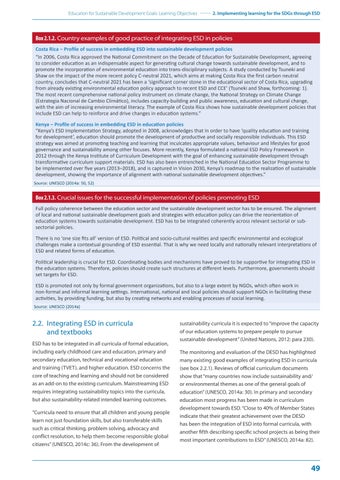Education for Sustainable Development Goals: Learning Objectives
2. Implementing learning for the SDGs through ESD
Box 2.1.2. Country examples of good practice of integrating ESD in policies Costa Rica – Profile of success in embedding ESD into sustainable development policies “In 2006, Costa Rica approved the National Commitment on the Decade of Education for Sustainable Development, agreeing to consider education as an indispensable aspect for generating cultural change towards sustainable development, and to promote the incorporation of environmental education into trans-disciplinary subjects. A study conducted by Tsuneki and Shaw on the impact of the more recent policy C-neutral 2021, which aims at making Costa Rica the first carbon neutral country, concludes that C-neutral 2021 has been a ‘significant corner stone in the educational sector of Costa Rica, upgrading from already existing environmental education policy approach to recent ESD and CCE’ (Tsuneki and Shaw, forthcoming: 1). The most recent comprehensive national policy instrument on climate change, the National Strategy on Climate Change (Estrategia Nacional de Cambio Climático), includes capacity-building and public awareness, education and cultural change, with the aim of increasing environmental literacy. The example of Costa Rica shows how sustainable development policies that include ESD can help to reinforce and drive changes in education systems.” Kenya – Profile of success in embedding ESD in education policies “Kenya’s ESD Implementation Strategy, adopted in 2008, acknowledges that in order to have ‘quality education and training for development’, education should promote the development of productive and socially responsible individuals. This ESD strategy was aimed at promoting teaching and learning that inculcates appropriate values, behaviour and lifestyles for good governance and sustainability among other focuses. More recently, Kenya formulated a national ESD Policy Framework in 2012 through the Kenya Institute of Curriculum Development with the goal of enhancing sustainable development through transformative curriculum support materials. ESD has also been entrenched in the National Education Sector Programme to be implemented over five years (2013–2018), and is captured in Vision 2030, Kenya’s roadmap to the realization of sustainable development, showing the importance of alignment with national sustainable development objectives.” Source: UNESCO (2014a: 50, 52)
Box 2.1.3. Crucial issues for the successful implementation of policies promoting ESD Full policy coherence between the education sector and the sustainable development sector has to be ensured. The alignment of local and national sustainable development goals and strategies with education policy can drive the reorientation of education systems towards sustainable development. ESD has to be integrated coherently across relevant sectorial or subsectorial policies. There is no ‘one size fits all’ version of ESD. Political and socio-cultural realities and specific environmental and ecological challenges make a contextual grounding of ESD essential. That is why we need locally and nationally relevant interpretations of ESD and related forms of education. Political leadership is crucial for ESD. Coordinating bodies and mechanisms have proved to be supportive for integrating ESD in the education systems. Therefore, policies should create such structures at different levels. Furthermore, governments should set targets for ESD. ESD is promoted not only by formal government organizations, but also to a large extent by NGOs, which often work in non-formal and informal learning settings. International, national and local policies should support NGOs in facilitating these activities, by providing funding, but also by creating networks and enabling processes of social learning. Source: UNESCO (2014a)
2.2. Integrating ESD in curricula and textbooks ESD has to be integrated in all curricula of formal education, including early childhood care and education, primary and secondary education, technical and vocational education and training (TVET), and higher education. ESD concerns the core of teaching and learning and should not be considered as an add-on to the existing curriculum. Mainstreaming ESD requires integrating sustainability topics into the curricula, but also sustainability-related intended learning outcomes. “Curricula need to ensure that all children and young people learn not just foundation skills, but also transferable skills such as critical thinking, problem solving, advocacy and conflict resolution, to help them become responsible global citizens” (UNESCO, 2014c: 36). From the development of
sustainability curricula it is expected to “improve the capacity of our education systems to prepare people to pursue sustainable development” (United Nations, 2012: para 230). The monitoring and evaluation of the DESD has highlighted many existing good examples of integrating ESD in curricula (see box 2.2.1). Reviews of official curriculum documents show that “many countries now include sustainability and/ or environmental themes as one of the general goals of education” (UNESCO, 2014a: 30). In primary and secondary education most progress has been made in curriculum development towards ESD. “Close to 40% of Member States indicate that their greatest achievement over the DESD has been the integration of ESD into formal curricula, with another fifth describing specific school projects as being their most important contributions to ESD” (UNESCO, 2014a: 82).
49


